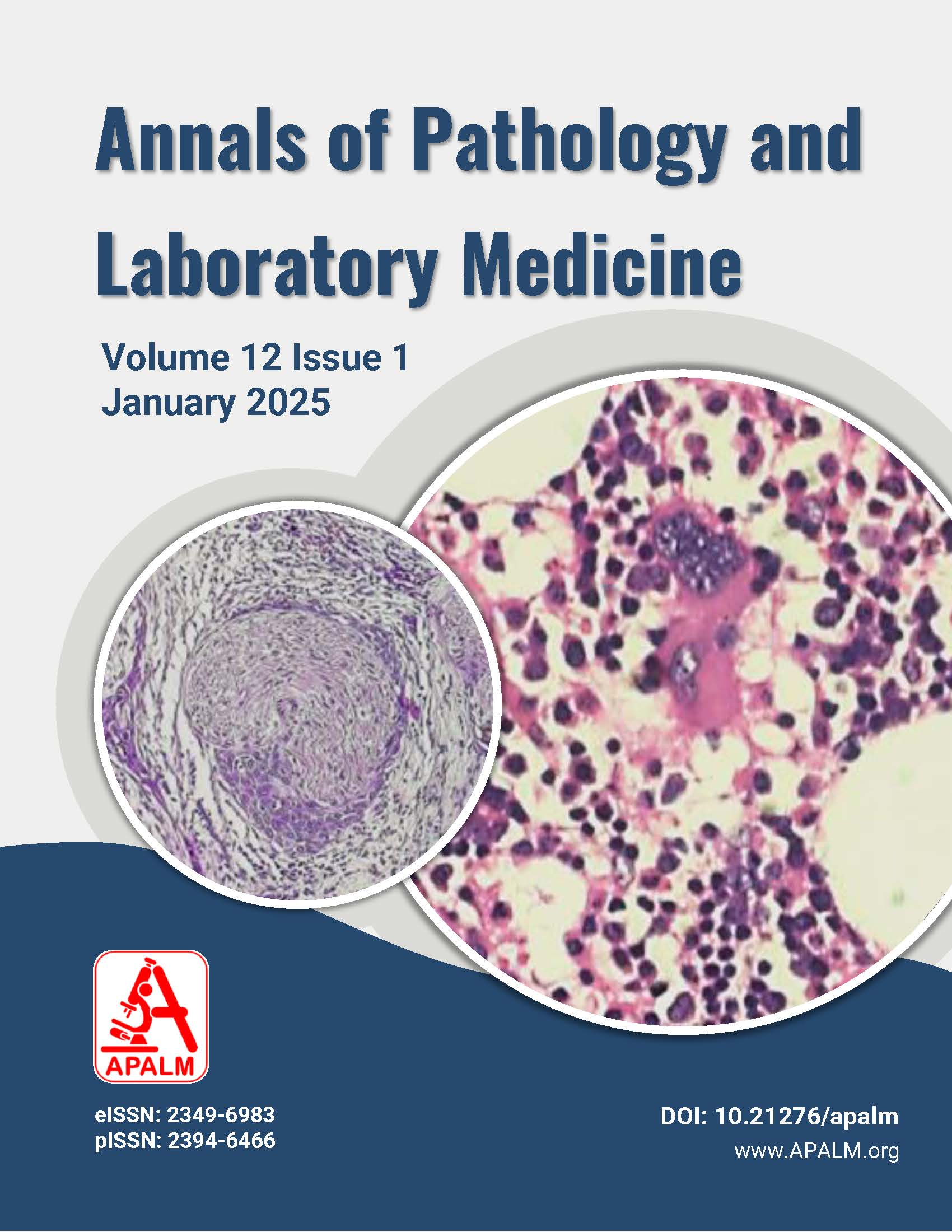Bladder Endometriosis: A Great Masquerader
DOI:
https://doi.org/10.21276/apalm.3456Keywords:
Bladder, endometriosis, estrogen receptors, progesterone receptorsAbstract
Endometriosis is a chronic condition presenting with the presence of endometrium outside the uterus. Case 1: A 29-year-old woman presented with abdominal pain and painful urination for 15 days, beginning after her menstrual cycle. She had a history of frequent urination, recurrent urinary tract infections, hematuria, and two uneventful cesarean sections. Ultrasound revealed a lobulated soft tissue lesion in the posterior bladder wall. Microscopy revealed endometrial glands and hemosiderin-laden macrophages. Immunohistochemistry (IHC) confirmed bladder endometriosis with positive estrogen and progesterone receptors (ER/PR) and CD10-positive stromal cells. Case 2: A 33-year-old woman with menorrhagia, dysmenorrhea, and burning urination underwent surgery for a fibroid and ovarian cyst. During surgery, a 6.5 cm firm mass adhered to the bladder and uterus was found. Histopathology confirmed bladder endometriosis with ER-positive glands. The diagnosis of bladder endometriosis is aided by imaging techniques along with histopathology and IHC. This comprehensive approach helps differentiate bladder endometriosis from malignancies or other gynecological conditions, thus reducing the risk of misdiagnosis. Early and precise diagnosis facilitates targeted treatment, improving patient outcomes and preventing unnecessary interventions.
References
1. Parasar P, Ozcan P, Terry KL. Endometriosis: epidemiology, diagnosis and clinical management. Curr Obstet Gynecol Rep. 2017;6(1):34–41.
2. Seracchioli R, Mabrouk M, Montanari G, Manuzzi L, Concetti S, Venturoli S. Conservative laparoscopic management of urinary tract endometriosis (UTE): surgical outcome and long-term follow-up. Fertil Steril. 2010;94(3):856–61.
3. Chapron C, Chopin N, Borghese B, Foulot H, Dousset B, Vacher-Lavenu MC, et al. Deeply infiltrating endometriosis: pathogenetic implications of the anatomical distribution. Hum Reprod. 2006;21(7):1839–45.
4. Aliramaji A, Darzi AA, Shafi H, Ramezani MS. Bladder endometriosis: a case report. World Appl Sci J. 2011;15(12):1758–60.
5. Nezhat C, Nezhat F, Nezhat CH, Nasserbakht F, Rosati M, Seidman DS. Urinary tract endometriosis treated by laparoscopy. Fertil Steril. 1996;66(6):920–4.
6. Guerriero S, Condous G, van den Bosch T, Valentin L, Leone FP, Van Schoubroeck D, Exacoustos C, et al. Systematic approach to sonographic evaluation of the pelvis in women with suspected endometriosis, including terms, definitions and measurements: a consensus opinion from the International Deep Endometriosis Analysis (IDEA) group. Ultrasound Obstet Gynecol. 2016;48(3):318–32.
7. Nisenblat V, Bossuyt PM, Shaikh R, Farquhar C, Jordan V, Scheffers CS, Mol BW, et al. Blood biomarkers for the non-invasive diagnosis of endometriosis. Cochrane Database Syst Rev. 2016;2016(5):CD012179.
8. Fuentes Pastor J, Ballestero Diego R, Correas Gómez MÁ, Torres Díez E, Fernández Flórez A, Ballesteros Olmos G, et al. Bladder endometriosis and endocervicosis: presentation of 2 cases with endoscopic management and review of literature. Case Rep Urol. 2014;2014:296908.
9. Wellbery C. Diagnosis and treatment of endometriosis. Am Fam Physician. 1999 Oct 15;60(6):1753–62, 1767–8.
10. Trigui M, Ouanes Y, Chaker K, Zehani A, Chelly I, Nouira Y. Bladder endometriosis: a serious disease. Urol Case Rep. 2023;48:102400.
11. Bloom R, LaRusso S. Endometriosis with bladder involvement. J Diagn Med Sonogr. 2010;26(5):260–2.
12. Töz E, Ince O, Apaydın N, Gürbüz T, Dayanıklı N, Ayaz D. A case of bladder endometriosis that became symptomatic during the third trimester. Case Rep Womens Health. 2015;6:1–3.
13. Nishikawa A, Kondoh E, Hamanishi J, Yamaguchi K, Ueda A, Sato Y, et al. Ileal perforation and massive intestinal haemorrhage from endometriosis in pregnancy: case report and literature review. Eur J Obstet Gynecol Reprod Biol. 2013;170(1):20–4.
Downloads
Published
Issue
Section
License
Copyright (c) 2025 Parveen Rana, Sunaina Hooda, Ruchi Agarwal, Parul, Monika Gathwal, Vishal Rohilla, Swaran Kaur Saluja

This work is licensed under a Creative Commons Attribution 4.0 International License.
Authors who publish with this journal agree to the following terms:
- Authors retain copyright and grant the journal right of first publication with the work simultaneously licensed under a Creative Commons Attribution License that allows others to share the work with an acknowledgement of the work's authorship and initial publication in this journal.
- Authors are able to enter into separate, additional contractual arrangements for the non-exclusive distribution of the journal's published version of the work (e.g., post it to an institutional repository or publish it in a book), with an acknowledgement of its initial publication in this journal.
- Authors are permitted and encouraged to post their work online (e.g., in institutional repositories or on their website) prior to and during the submission process, as it can lead to productive exchanges, as well as earlier and greater citation of published work (See The Effect of Open Access at http://opcit.eprints.org/oacitation-biblio.html).










